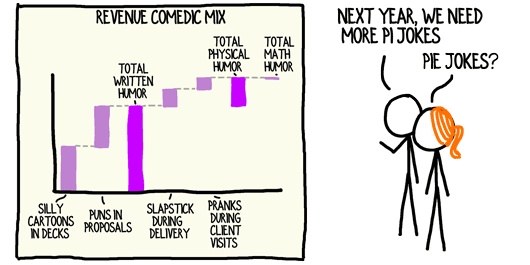You have probably set a revenue target for your consulting firm for the coming year. Good on you! Now, position your consulting firm for an even better year by considering the mix of your revenue.

Your consulting firm’s revenue mix is simply the composition of the dollars (or euros, pounds, shekels, yuan, etc.) your firm wins, divided into categories on some dimension.
It’s like the truffles in the box your best consulting client sends you.* They can be sorted based on the Type of Chocolate dimension (dark, light, white*), or the Filling dimension (solid, truffle, jam, wafer), or the Time to Eat dimension (already eaten, eaten by end of today).
Once you start diving into revenue mix you’ll realize there are far more dimensions on which you can slice and dice your revenue than you can realistically manage or target.
My team and I quickly identified over a dozen dimensions of consulting firm revenue mix, ten of which are presented below. In virtually every case, the examples on the flip side of the dimensions shown below are truly illustrative—the actual buckets for your consulting firm are likely to be quite different.
Consulting Firm Revenue Mix Dimensions
Client Status
(e.g., new clients, repeat clients, return clients, trade-up clients)
Client Type
(e.g., startup, private, P.E.-backed, public)
Client Industry
(e.g., snack goods, chocolate distributors, irrelevant)
Project Type
(e.g., advisory, workshop, end-to-end)
Source of Project
(e.g., direct, partner, staffing firm, candy-wrapper advertisement)
Offering/Service Line
(e.g., strategic planning, dashboard development, staff augmentation)
Enjoyability
(e.g., unenjoyable, tolerable, interesting, a blast)
Strategic Fit
(e.g., off strategy, adjacent, aligned)
Labor Intensity
(e.g., DFY, DIY, hybrid)
Engagement Fee Structure
(e.g., fixed, success-based, stipend, time & materials)
On its own, a kaleidoscope of revenue mix dimensions isn’t particularly helpful, because it’s unrealistic to set targets for your consulting firm on every dimension.

Therefore, employ the following, four-step revenue mix analysis to improve your consulting firm’s goals for the upcoming year:
4-Step Consulting Revenue Mix Analysis
1. Stretch
Challenge yourself to assess your consulting business on multiple dimensions of mix. Analyze your performance on at least five of the ten dimensions listed below.
2. Observe
As you review your consulting firm’s mix, consider the implications. What does your historical and desired performance tell you about…
- Who you target?
- What you offer?
- How high/low you price engagements?
- Your fee structures?
- What projects you (will) accept or decline?
- What channels you use for marketing?
- What messages you use in marketing?
- What capabilities you need to build?
- What resources you need to acquire?
3. Conclude
Synthesize the results of your analysis – what are the commonalities and, overall, where do they point your consulting firm?
4. Target
Prioritize one, two or, at most, three revenue mix dimensions and set those as targets for the year.
The results of your mix analysis are likely to manifest in your consulting firm’s results next year.
There’s absolutely no doubt that your intentions affect your results. While you won’t always hit your revenue mix targets precisely, you’ll find that generally what you target, you’ll achieve.
As a result, using a mix analysis to prioritize your consulting firm’s incoming business will lead to your consulting firm winning more of the type of business you want.
What’s one way you’re looking at your revenue mix for the coming year?
Text and images are © 2024 David A. Fields, all rights reserved.

 David A. Fields Consulting Group
David A. Fields Consulting Group 

Great article. We look at history in several dimensions and have focused on adjusting mix over time. We have not set goals around mix specifically. Worth trying for next year.
We currently track: company size, ownership type (PE, Private, Public), service type, and sales source. We have consciously tried to influence the mix around ownership type and service type in the past. I want to add project size to our tracking to try to determine how we can increase our average project revenue.
Those are very good examples of mix and being intentional about your business development, Bruce. Interesting that you track ownership type–I assume that makes a meaningful difference in the quality of the project for your firm.
Looking at project size is a good idea. My guess is that it will go as you track it because you’re focused on project size. Definitely let me know how that works out for you.
Thanks for taking the time to share how you’ve approached mix, Bruce. Very helpful!